DayQ
Many years ago these speaker cabinets housed an MTM design using a pair of Audax AT080M0 paper cone drivers and a tiny TW010F1 tweeter. The crossover point was high and the sound was decent even if a tad unnatural. These speakers were built for my parents bedroom but, as is usual with these old foam surround drivers, the surrounds perished.
Obviously this meant that the speakers were not usable and a replacement was necessary. One of the downsides of having speaker design as a hobby is having far too many ideas but not enough actual uses for loudspeakers, so the requirement for a new pair was met with considerable delight!
Reusing the old cabinets was high on the list as there was nothing wrong with them, but different driver cutouts weren't going to fit so something had to be done. The easiest solution to this was to add a layer of wood over the old cutouts and make new ones in the wood front. I also reveneered the cabinets first in an attractive cheery I had picked up for a good price on ebay.
Another MTM design was out of the question as most listening was done casually and off axis from the tweeter of the old design. As these speakers were only 60cm tall a main design listening axis above the loudspeaker was intended and a TM made the most sense.
Dayton Audio's reference series of drivers have always had a very impressive bang to buck ratio with excellent performance across the board. This design was completed several years ago now and at the time the RS125-8 optimised well into a large ported cabinet. It gives a surprising amount of bass extension, especially given the driver size, but comes at a price, a large cabinet. Dayton have since changed the driver so that it optimises into a much smaller cabinet. This is useful for probably most intended applications for a driver of this size, small bookshelves, MTMs, 2.5 ways etc. The old version though was perfect here giving nice extension down to 50Hz.
Given the RS125s pedigree a suitably capable tweeter was deemed necessary, but one that also, like the RS125, didn't cost an arm and a leg. Having seen Zaph's measurements of the DQ25 it seemed foolish to go with anything else. Certainly the price was right as was the metal dome. With the perfectly pistonic operation of the bass driver it seemed fitting to go with an all metal build. With 4th order acoustic slopes it had the capability to go down to 2kHz, something that the RS125 might require. My target xover point was from 2-2.5kHz, firstly to reduce off axis issues in a speaker intended mostly for casual listening and secondly to mitigate the peak in the third order distortion of the RS125 present at ~2.7kHz.
Obviously this meant that the speakers were not usable and a replacement was necessary. One of the downsides of having speaker design as a hobby is having far too many ideas but not enough actual uses for loudspeakers, so the requirement for a new pair was met with considerable delight!
Reusing the old cabinets was high on the list as there was nothing wrong with them, but different driver cutouts weren't going to fit so something had to be done. The easiest solution to this was to add a layer of wood over the old cutouts and make new ones in the wood front. I also reveneered the cabinets first in an attractive cheery I had picked up for a good price on ebay.
Another MTM design was out of the question as most listening was done casually and off axis from the tweeter of the old design. As these speakers were only 60cm tall a main design listening axis above the loudspeaker was intended and a TM made the most sense.
Dayton Audio's reference series of drivers have always had a very impressive bang to buck ratio with excellent performance across the board. This design was completed several years ago now and at the time the RS125-8 optimised well into a large ported cabinet. It gives a surprising amount of bass extension, especially given the driver size, but comes at a price, a large cabinet. Dayton have since changed the driver so that it optimises into a much smaller cabinet. This is useful for probably most intended applications for a driver of this size, small bookshelves, MTMs, 2.5 ways etc. The old version though was perfect here giving nice extension down to 50Hz.
Given the RS125s pedigree a suitably capable tweeter was deemed necessary, but one that also, like the RS125, didn't cost an arm and a leg. Having seen Zaph's measurements of the DQ25 it seemed foolish to go with anything else. Certainly the price was right as was the metal dome. With the perfectly pistonic operation of the bass driver it seemed fitting to go with an all metal build. With 4th order acoustic slopes it had the capability to go down to 2kHz, something that the RS125 might require. My target xover point was from 2-2.5kHz, firstly to reduce off axis issues in a speaker intended mostly for casual listening and secondly to mitigate the peak in the third order distortion of the RS125 present at ~2.7kHz.
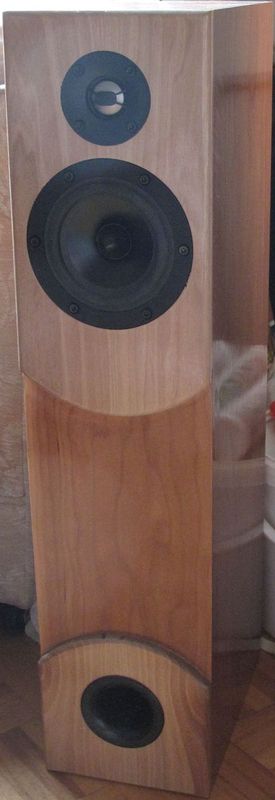
Given that we've just discussed the ported alignment, and the drivers impressive bass extension, it seems fitting to start there.
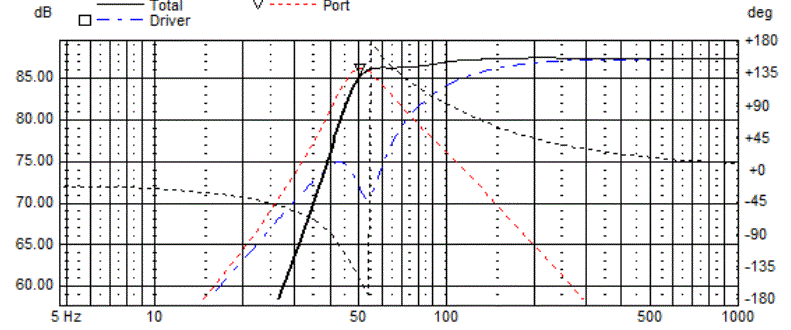
As can be seen, not bad for such a small driver and extension that is certainly pleasing in room. These speakers do not sound bass light and are very enjoyable with most types of music.
Next up are some measurements for the crossover design. As these speakers are so short everything was measured and optimised for a designn axis significantly above the tweeters axis.
Next up are some measurements for the crossover design. As these speakers are so short everything was measured and optimised for a designn axis significantly above the tweeters axis.
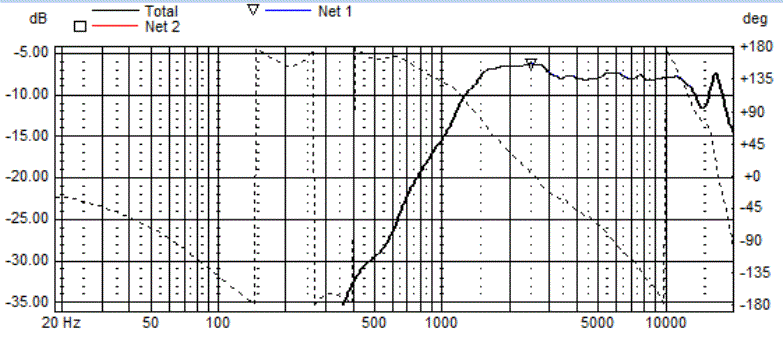
The DQ25s frequency response is pretty much what was expected, a slight top end droop, due to being a little off axis, and a bit of a high Qts bump, this is a small, chamberless, neo afterall.
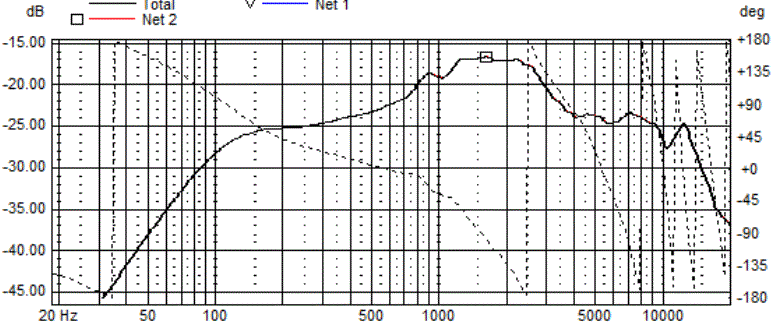
The RS125s response looks a little mishapen at first but after a bit of thought it all makes sense. First of all bafflestep is included within this response which accounts for 6dB of the falling response towards low frequencies. The RS125 has a slight rising response above this, creating that hump, and then, due to the nature of stiff cone drivers, falls away not particularly high in frequency. The bell mode resonance isn't particularly well developed due to the off axis angle at which it was measured.
The crossover design was actually fairly straight forward, which isn't always the case with passive xovers and it's a nice relief when it comes together more easily than it could have.
The simulated frequency response is shown bellow.
The crossover design was actually fairly straight forward, which isn't always the case with passive xovers and it's a nice relief when it comes together more easily than it could have.
The simulated frequency response is shown bellow.
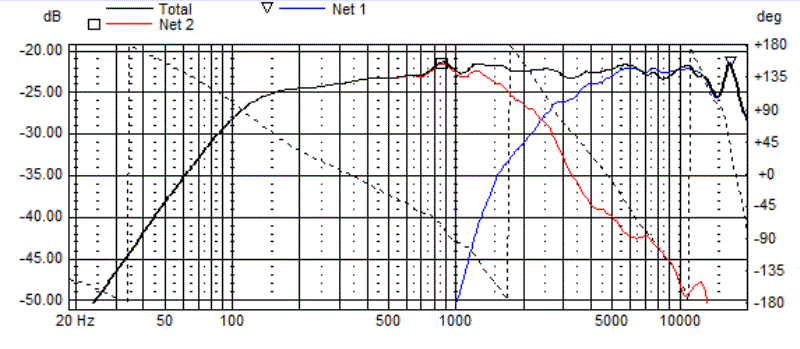
3dBs worth of bafflestep compesnation were chosen due to the speakers being placed relatively close to side/backwalls. The xover happened to fall into place around 2.5kHz, perfect for helping to keep the RS125s distortion spike out of the way and for giving the DQ25 an easier job than it would have had down at 2kHz. Shown below is the reverse polarity null.
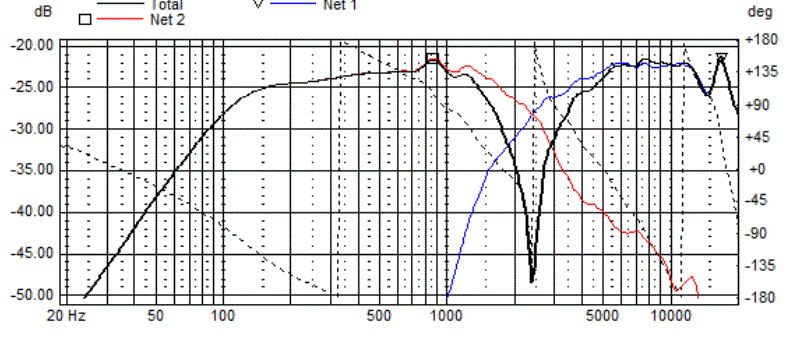
As can be seen driver integration is excellent with very little asymmetry required in the crossover to bring the drivers into good alignment. The crossover is also relatively simple. First up is the tweeter.

Third order electrical with an Lpad.
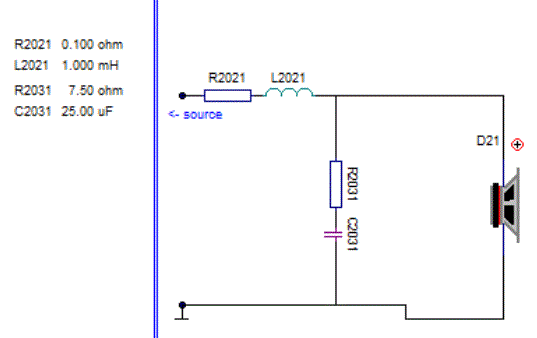
And for the woofer as basic and simple as it gets.
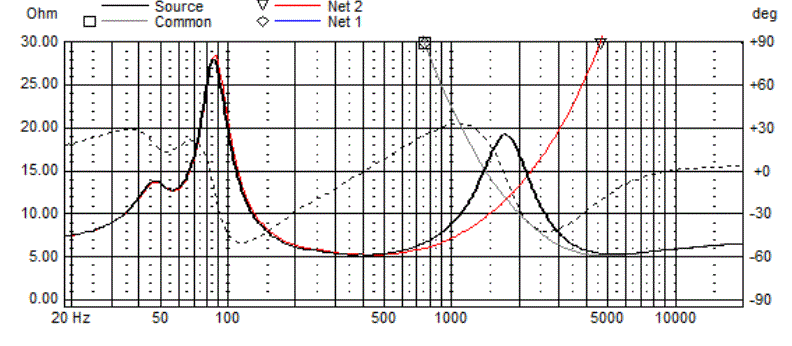
The impedance was also optimised so as to be easy on the amplifier.
In practise these speakers sound fantastic, clean, clear and relaxed. As mentioned before the bass performance of these speakers is very impressive for their size, their only caveat is that they don't go particularly loud, but you cannot have it all!
In practise these speakers sound fantastic, clean, clear and relaxed. As mentioned before the bass performance of these speakers is very impressive for their size, their only caveat is that they don't go particularly loud, but you cannot have it all!